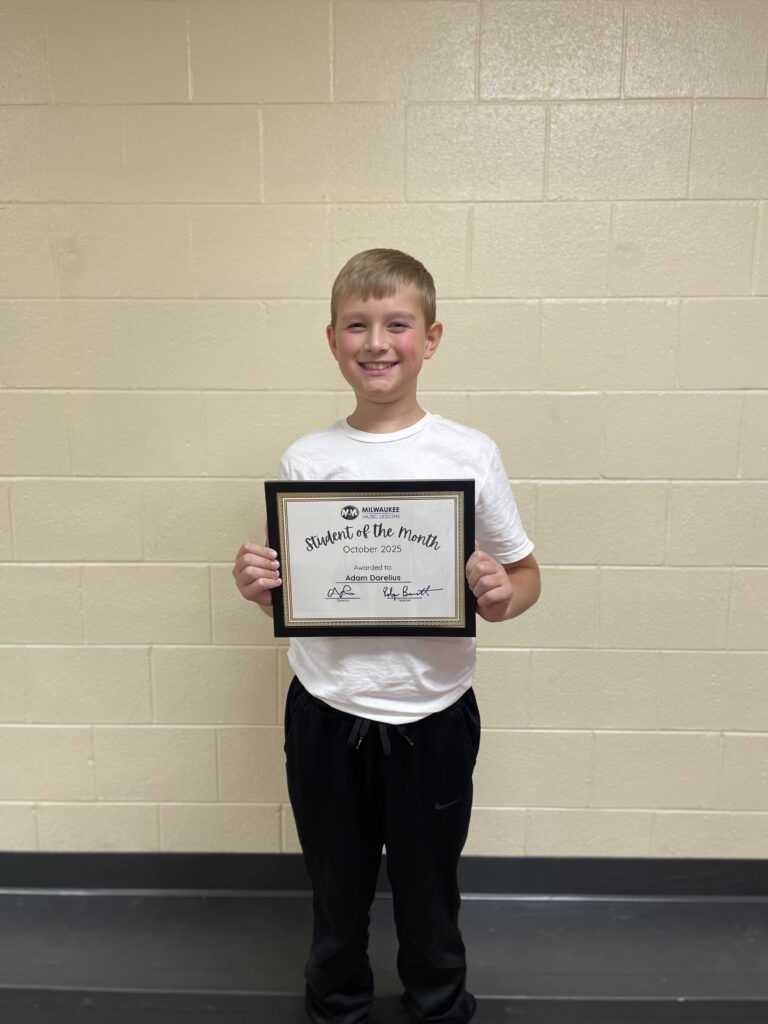Upcoming Workshops
This Month’s Workshop:
Ear Training: Getting Better At Rhythm
When: Monday, November 3rd
Time: 7-7:45pm
Where: Virtual
Next Month’s Workshop:
Music Theory II: Chords in Music
When: Monday, December 1st
Time: 7-7:45pm
Where: Virtual
Student of the Month
Adam was chosen as the student of the month because of his consistent ability to go above and beyond. He always puts forward 110% and best of all, he does it with a smile.
Name: Adam
Instrument: Piano
Time Playing: 3 Years
Favorite Song Learned So Far: The Easy Winners
Dream Song To Play: Linus And Lucy from A Charlie Brown Christmas
Favorite Non Music Activity: Legos and Baseball Cards

This Months Workshop: Rhythm
Our November workshop is all about understanding timing and training your ear to recognize rhythmic patterns.
Unlike melodies or chords, rhythm isn’t something you can point to on a fretboard or keyboard. It lives on an invisible timeline — a shared pulse that every musician in the band locks into together.
Mastering this skill takes practice, patience, and awareness.
In this workshop, we’ll break down the fundamentals of rhythm and give you practical ways to strengthen your sense of timing so you can keep improving at home.
Cool Gear of the Month
The fretless bass is a unique instrument that stands apart from its fretted cousin because it has a smooth fingerboard with no metal frets. Instead of pressing strings between frets, the player places their fingers directly on the wood to change pitch—much like how a violin or upright bass works. This gives the player far more control over pitch and vibrato, allowing for smooth slides, subtle bends, and an expressive singing tone that’s hard to match on a fretted instrument.
In classic rock, you can hear the fretless bass shine in several legendary recordings. Jaco Pastorius famously brought it to the spotlight with his work on Joni Mitchell’s albums. Even Sting used fretless bass in The Police, giving songs like “Walking on the Moon” their signature floating groove.

Guitar Lesson: Hammer-Ons and Pull-offs
Hammer-ons and pull-offs are two simple tricks that make your playing sound smoother and faster without having to pick every note. A hammer-on happens when you pick a note once, then use a finger from your fretting hand to “hammer” down onto the next fret. This creates a new note without picking again. Think of it like tapping your finger on a touchscreen—you only need a little speed and accuracy to make it work. Start slow: pick the 5th fret on the 3rd string, then quickly hammer your finger onto the 7th fret. You’ll hear two notes, but only picked once.
A pull-off is the opposite. You pick the higher note first, then “pull” your finger off to let the lower note ring out. The key is to give the string a slight flick as you lift, almost like plucking down with your fretting finger. Try fretting the 7th fret and pulling off to the 5th. When you put these together, you get a flowing sound that’s perfect for riffs, solos, and warm-ups. Slow and clean is the secret—speed comes after control.
Jamming 101: A Beginner’s Guide to Improvisation in Blues and Rock
We’ve been looking for a fun and meaningful way to celebrate your milestones and accomplishments. That’s why we’re excited to share our brand-new Milestone Buttons — a cool, collectible way to show off your progress and all the hard work you’ve put in.
If you’ve been with us for a while and missed any buttons from past milestones, no worries! Just let us know, and we’ll make sure to get them to you as soon as possible.

Music Theory: Counterpoint
Counterpoint is the art of combining two or more independent musical lines so they sound good together. Instead of one melody with simple chords underneath, each part has its own shape, rhythm, and direction. You’ll hear this often in classical music, but it also shows up in jazz, rock, and even film scores. One melody might rise while another falls, creating movement and tension. When done right, it feels like two voices are having a conversation — each with its own story, but perfectly in sync.
Counterpoint works with both rhythm and harmony. For example, imagine one guitar holding steady half notes while another plays a syncopated rhythm on top — the contrast makes the groove feel alive. Or picture a piano part where the right hand plays a flowing melody while the left hand moves in a different direction, outlining the chords. The magic happens in how these lines weave together: different, but balanced. That’s the heart of counterpoint — independent voices creating a richer, more layered sound.
Robyn’s Maternity Leave
Robyn is getting ready for the arrival of our new baby! With a due date in early December, she’ll be on maternity leave for two months starting the week after Thanksgiving and plans to return in February.
For All Studio Students
- Lessons will continue as usual with a substitute teacher during December–January.
- We may need to adjust some lesson times to accommodate the sub.
- You’ll receive a short scheduling survey soon so we can lock in times early.
For All WELS Students
- We’re actively searching for a substitute from within the synod.
- If we secure a qualified sub, lessons will continue as normal, including email follow-ups and materials.
- If we do not find a suitable sub, we will pause monthly payments until Robyn’s return in February.
If you have any questions, please reach out to Alex at Alex@mkelessons.com.
Thanksgiving Break
For Studio Students:
We’ll be taking a short break from November 24–30. Regular lessons will resume on December 1.
For All Students:
We’re opening extra make-up lesson times on Monday, November 24 and Tuesday, November 25 from 5–7 PM.
If you have a make-up credit you’d like to use, you can reserve a spot by reaching out to Alex via email or phone.
Parent Practice Guide
Most students, especially kids, love to play through their favorite songs from start to finish. It feels fun, familiar, and easy. But here’s the catch — just running through a song doesn’t actually help them get better at the tough parts. Real progress happens in the small moments, not the big run-through.
Here’s a simple strategy to help your child practice smarter, not longer:
- Pick a small section — one line, one measure, or one tricky transition.
- Play it slowly and repeat it until it feels smooth.
- Memorize just that piece before moving on.
- Stack it with the next section, like puzzle pieces coming together.
This method builds confidence fast. When students start stringing together small wins, they not only sound better — they feel like they’re improving. That momentum is what keeps them excited to practice.
Student Milestones
3 Months
Arthur D.
William S.
6 Months
Cecilia M.
Robin M.
JJ R.
Moriah Y.
Maria C.
Anaka G.
Aaron S.
9 Months
Kaden W.
John S.
Belle B.
Kuldeep M.
Daniel R.
Cory N.
Parker O.
Adriana O.
Delaney K.
1 Year
Jim K.


